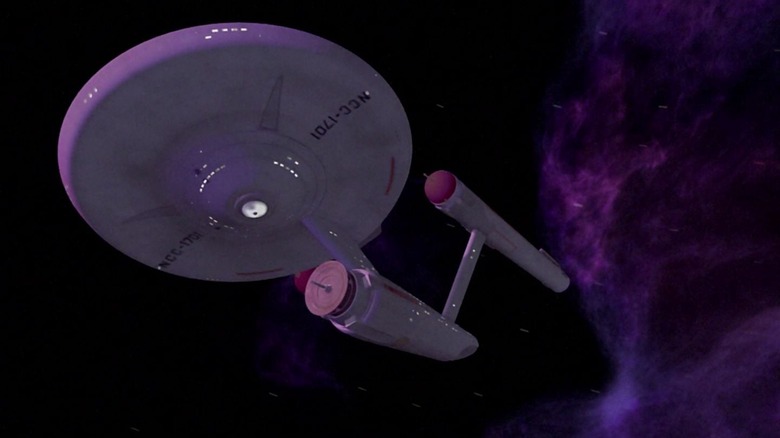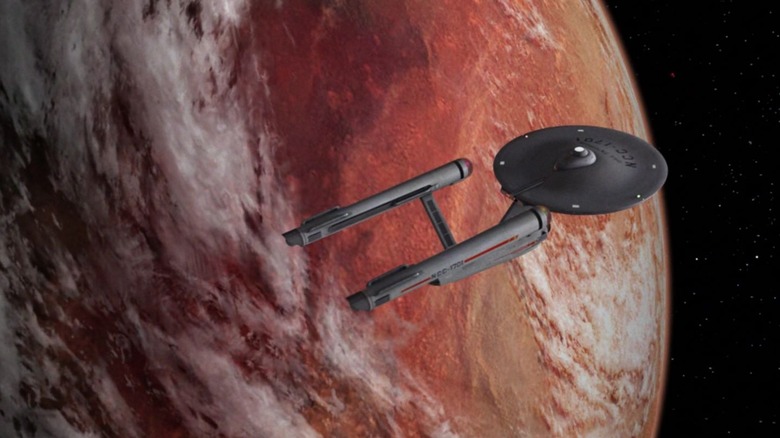We may receive a commission on purchases made from links.

Paramount
"Star Trek" debuted in 1966, meaning audiences have been staring at the U.S.S. Enterprise for nearly 60 years. As such, it's hard to imagine the ship looking any differently than it does. The Enterprise is a flying saucer that sports a thin aft "neck" extension protruding from its underside. The "neck" then connects with a wide, cigar-shaped body that has an outsize satellite dish on the front. Protruding upward from the cigar body are two offset tube-like engines (called nacelles), held aloft from the ship by thin planks that stick out at 90-degree angles.
The design of the Enterprise isn't so much elegant as it is industrial. The sharp angles and spindly frame bring to mind shuttle-like efficiency more than gorgeous aesthetics. It wouldn't be until 1979, when the Enterprise was redesigned for "Star Trek: The Motion Picture," that the ship would become more streamlined and "aerodynamic" (which, of course, isn't an issue in the vacuum of space).
The original Enterprise was designed by Matt Jeffries, who also designed the Enterprise's bridge, its sickbay, and other ancillary details like handheld phasers, Klingon ships, and the Klingon Empire's emblem, all of which are used in "Star Trek" to this day. Jeffries submitted designs for the Enterprise's shuttlecraft as well, but they were deemed too complicated, so the show's creatives went with a simpler design by Gene Winfield.
Jeffries' Enterprise design was dictated by "Star Trek" creator Gene Roddenberry, who envisioned the ship as looking a certain way. Together, they came up with the idea that the Enterprise's engines were so powerful, they needed to be held away from the ship. Indeed, according to the Ex-Astris-Scientia website, Roddenberry had four rules Jeffries needed to follow when inventing a starship.
Rule #1: Warp nacelles must be in pairs

Paramount
Note: Roddenberry's tips for starship designs weren't officially written down until the days of "Star Trek: The Next Generation" in 1987, so a lot of the following details are more closely extrapolated from the Enterprise-D than the original Enterprise. Many of the technicals are, likewise, based on the scientific consultations from "The Next Generation."
Roddenberry felt that every starship in "Star Trek" would have two engines held out from the central hull. This would seemingly assure a certain degree of symmetry, as well as evoke an elegant catamaran-like look. The warp nacelles, to my eye, look more like methods of propulsion than mere wings. They also imply a greater speed and freedom of movement than one might assume from the more traditional rocket-on-the-back design of real-life rockets. One might like the rocket-like ship designs in "Star Wars," but the glowing engines on their backs make this tech nerd wonder how they brake in the vacuum of space. Are there smaller rockets on the front?
"Star Wars" fans can chime in to explain the technical details of the Millennium Falcon if they so wish.
Later in the life of the "Star Trek" franchise — in about 1987 — palpable scientific reasons would be applied to the two-engine design and why the engines needed to be held aloft. The engines, you see, create a warp field around the Enterprise, stretching the fabric of space itself, allowing it to seemingly travel faster than light. The engines aren't like traditional thrusters, but complex gravitational manipulators. In order to contain a ship entirely within a warp field, there need to be two engines working in tandem. A third nacelle would be extraneous, and a single engine is too little.
Rule #2: Warp nacelles must have at least 50% line-of-sight on each other across the hull

Paramount
The Enterprise-D, as it appeared on "Star Trek: The Next Generation," was designed by Andrew Probert, and he followed Roddenberry's mandate as closely as he could. The new ship was smoother and rounder and featured almost no right angles. It was like a seashell.
Roddenberry didn't like the idea of a Starfleet vessel being totally flat, though. Two engines could have, by the above technical specifications, been held directly out from the sides of a starship like wings, but that wouldn't look right to Roddenberry's taste. If one were to look at a starship from the side, the two warp nacelles had to rest a little higher than the main body of the ship. That's what he meant with his rules that dictated that warp nacelles must have at least 50% line-of-sight on each other across the hull.
This, as above, would have to do with the warp field, but also simply looked better. Two engines that stuck out to the sides wouldn't look as dynamic.
In later "Star Trek" shows, made after Roddenberry's death, the raised-engines mandate would be stretched a bit. The U.S.S. Defiant seen on "Star Trek: Deep Space Nine," for instance, was a solid chonker of a ship, with more internally constructed engines and a flat body. Elsewhere, the U.S.S. Voyager on "Star Trek: Voyager" held its engines at its sides when traveling at sub-warp speeds. However, the engines would reconfigure positions when going to warp, angling upward in a more traditional fashion.
Rule #3: Both warp nacelles must be fully visible from the front

Paramount
One might note that the Enterprise's warp nacelles are usually "capped" at the front with red rocket tips. A look through various "Star Trek" technical manuals — specifically Rick Sternbach and Mike Okuda's "Star Trek: The Next Generation Technical Manual" — label those rocket tips as Bussard ramscoops, and they are designed to collect and store the various cosmic particles that a starship would inevitably run into in deep space. Single hydrogen atoms could be sucked up, as well as great clouds of spatial gases. In the 1998 film "Star Trek: Insurrection," the Enterprise-E uses its ramscoops to vacuum up and then blast out a stream of explosive gas to fend off an attacker. Most of the gases are converted into energy or simply used for study and/or navigation purposes.
Because they need to suck up gas, the warp engines, by Roddenberry's mandate, need to be unobstructed by other parts of the ship. When looking at a fore diagram of a starship, both bussard ramscoops needed to be visible. On the original "Star Trek," the ramscoops could be seen peeking up above the Enterprise's saucer section. On "Next Generation," they rested lower, below the saucer section.
The Enterprise-E was designed after Roddenberry's death, so its engines are only barely visible from the front. Technically, though, it follows Roddenberry's rule.
Rule #4: The bridge must be located at the top center of the primary hull

Paramount
In Phil Farrand's 1993 book "The Nitpicker's Guide for Next Generation Trekkers," the author pointed out a glaring design flaw in most Starfleet vessels. Ever since the very first shot of the Enterprise in the "Star Trek" pilot "The Cage," audiences have known that the bridge — full of the ship's vital control computers and its most important staff officers — sits right on the top of the ship. The bridge is, in Farrand's words, a hood ornament. Any enemy vessel wishing to do lasting damage to the Enterprise could easily target the bridge and blow the entire senior staff to kingdom come.
But it seems that Roddenberry wanted the bridge to be located right up top, easily seen from a dorsal view. This not only gives Starfleet captains a scientific, observational viewpoint of the galaxy, but also reveals that the ship is not a vessel of war. The senior staff sits up top, happy to be vulnerable, communicating that they are not here to start a fight in a fortified battleship. In terms of tactics, a top-located bridge may be unwise, but no Enterprise has been about tactics.
In "Next Generation" it was revealed that, in a pinch, the senior staff could gather on a secondary Battle Bridge anyway, so the design flaw was at least addressed.
This is a design quirk that has remained wholly consistent throughout "Star Trek." No ship has a hidden bridge, nor a bridge on its ventral side. The decks on a starship descend from the top. The bridge is deck one. The decks on the bottom of the ship are numbered the highest.
Other starship design quirks

Paramount
The 1968 book "The Making of Star Trek" reveals that Roddenberry also wanted the Enterprise to burn clean fuel. One of his notes was:
"We're [...] out in deep space, on the equivalent of a cruiser-size spaceship. We don't know what the mode of power is, but I don't want to see any trails of fire. No streaks of smoke, no jet intakes, rocket exhaust, or anything like that [...]. It will be like a deep space exploration vehicle, operating throughout our galaxy."
Trekkies can tell you that starship engines are powered by controlled matter/antimatter explosions. That is, in Roddenberry's vision, environmentally sound.
Longtime watchers of "Star Trek" also may observe other consistent starship design quirks throughout the franchise. Most notably, one might note the main deflector dish on every starship; that is, the large eye-like radar at the front of a starship's lower hull. This, Trekkies can tell you, is a navigational deflector that allows starships to accurately map out routes across great distances. These ships can, after all, fly over a thousand times the speed of light. Accurate navigation would be required.
One might also note that the saucers of most starships sport red, glowing engines on the back. Those are the ship's impulse engines, used for when a ship needs to travel at sub-warp speeds. Sternbach and Okuda's "Technical Manual" points out that starships use a magical device called inertial dampeners to make sure the crew isn't pinned to the back wall.
Know that the spindly Starfleet ship designs were no fluke. A lot of thought and effort went into their making.









 English (US) ·
English (US) ·